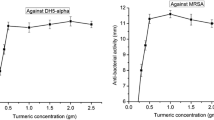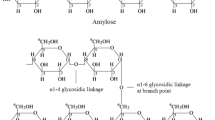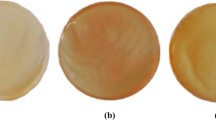Abstract
Wound care has come through various trials and errors with primitive cultures applying old age techniques and knowledge. Recent research has shown that the moist environment promotes wound healing than the dry. In the present research, hydrogel membranes were fabricated by esterification of polyvinyl alcohol (PVA) with starch and glutaraldehyde as a cross-linker. The essential oils (clove oil, Oregano oil and tea tree oil) have been incorporated in PVA/Starch based hydrogel membranes. The aim was to achieve optimized anti-bacterial activity and mechanical strength. The anti-bacterial testing was performed using the disc diffusion method. The maximum antibacterial activity for fabricated hydrogels was attained by addition of 0.1 mL clove oil in PVA/Starch hydrogel was 39 ± 0.57 mm and 37 ± 0.29 mm for MRSA and E. coli, respectively. The FTIR results presented the occurrence of –OH group in hydrogel membrane. The SEM results showed around dense nature of membranes with having an antibacterial agent in it or not. Mechanical examination of hydrogel membranes presented suitable tensile strength of 19.36 MPa for 0.1 mL Clove oil. Furthermore, water vapour transmission rate (WVTR) and moisture retention capability (MRC) for 0.1 mL clove oil was 36.22 g/m2h and 95.50%, respectively. The experimental conclusion nominated that fabricated hydrogel articulates good antibacterial, mechanical and physical properties that it could be used in wound dressing applications. The best results were obtained for clove oil using 0.1 mL as an antibacterial agent.
Graphic Abstract












Similar content being viewed by others
References
Clark WR, Gao D (2002) Properties of membranes used for hemodialysis therapy. Semin Dial 15(3):191–195
Kamoun EA, Kenawy ES, Chen X (2017) REVIEW A review on polymeric hydrogel membranes for wound dressing applications: PVA-based hydrogel dressings. J Adv Res 8(3):217–233
Madaghiele M, Demitri C, Sannino A, Ambrosio L (2014) Polymeric hydrogels for burn wound care: advanced skin wound dressings and regenerative templates. Burns Trauma 2(4):153–161
Arca HÇ, Şenel S (2008) Chitosan based systems for tissue engineering part II: soft tissues. ABAD J Pharm Sci 2:211–216
Daunton C, Kothari S, Smith L, Steele D (2014) A history of materials and practices for wound management. Wound Pract Res 20:174
Pal K, Banthia AK, Majumdar DK (2009) Polymeric hydrogels: characterization and biomedical applications. Des Monomers Polym 12(3):197–220
Yahia Lh (2017) History and applications of hydrogels. J Biomed Sci 04:02
Devices D, Lafayette W (2000) Structural design of hydrogels. pp 9–29
Hassan A, Niazi MBK, Hussain A, Farrukh S, Ahmad T (2018) Development of anti-bacterial PVA/starch based hydrogel membrane for wound dressing. J Polym Environ 26(1):235–243
Ratner BD, Hoffman AS (1976) Synthetic hydrogels for biomedical applications. ACS Publications, Washington
Hoffman AS (2012) Hydrogels for biomedical applications. Adv Drug Deliv Rev 64:18–23
Bursali EA, Coskun S, Kizil M, Yurdakoc M (2011) Synthesis, characterization and in vitro antimicrobial activities of boron/starch/polyvinyl alcohol hydrogels. Carbohydr Polym 83(3):1377–1383
Baratta MT, Dorman HJD, Deans SG, Figueiredo AC, Barroso JG, Ruberto G (1998) Antimicrobial and antioxidant properties of some commercial essential oils. Flavour Fragr J 13(4):235–244
Lai P, Roy J (2012) Antimicrobial and chemopreventive properties of herbs and spices. Curr Med Chem 11(11):1451–1460
Kalemba D, Kunicka A (2003) Kalemba-2003-antibacterial-properties-of-EO.pdf. pp 813–829
Devi KP, Nisha SA, Sakthivel R, Pandian SK (2010) Eugenol (an essential oil of clove) acts as an antibacterial agent against Salmonella typhi by disrupting the cellular membrane. J Ethnopharmacol 130(1):107–115
Chami F, Chami N, Bennis S, Bouchikhi T, Remmal A (2005) Oregano and clove essential oils induce surface alteration of Saccharomyces cerevisiae. Phyther Res 19(5):405–408
Nishigaki I, Peramaiyan R, Ramachandran V, Gnapathy E, Dhanapal S, Yutaka N (2010) Cytoprotective role of astaxanthin against glycated protein/iron chelate-induced toxicity in human umbilical vein endothelial cells. Phyther Res 24(June):54–59
Burt S (2004) Essential oils: their antibacterial properties and potential applications in foods - a review. Int J Food Microbiol 94(3):223–253
Myers SL, Yang CZ, Bittner GD, Witt KL, Tice RR, Baird DD (2015) Estrogenic and anti-estrogenic activity of off-the-shelf hair and skin care products. J Expo Sci Environ Epidemiol 25(3):271–277
Sánchez-González L, González-Martínez C, Chiralt A, Cháfer M (2010) Physical and antimicrobial properties of chitosan-tea tree essential oil composite films. J Food Eng 98(4):443–452
Jopke K, Sanders H, White-Traut R (2017) Use of essential oils following traumatic burn injury: a case study. J Pediatr Nurs 34:72–77
Li M et al (2016) Tea tree oil nanoemulsions for inhalation therapies of bacterial and fungal pneumonia. Colloids Surf B 141:408–416
Simitzis PE, Deligeorgis SG, Bizelis JA, Dardamani A, Theodosiou I, Fegeros K (2008) Effect of dietary oregano oil supplementation on lamb meat characteristics. Meat Sci 79(2):217–223
Khorasani MT, Joorabloo A, Moghaddam A, Shamsi H, MansooriMoghadam Z (2018) Incorporation of ZnO nanoparticles into heparinised polyvinyl alcohol/chitosan hydrogels for wound dressing application. Int J Biol Macromol 114:1203–1215
Roy N, Saha N, Kitano T, Vitkova E, Saha P (2011) Trends Colloid Interface Sci 14:127–130
Kenawy ER, Kamoun EA, MohyEldin MS, El-Meligy MA (2014) Physically crosslinked poly(vinyl alcohol)-hydroxyethyl starch blend hydrogel membranes: synthesis and characterization for biomedical applications. Arab J Chem 7(3):372–380
Yang J et al (2002) Fabrication and surface modification of macroporous poly(l-lactic acid) and poly(l-lactic-co-glycolic acid) (70/30) cell scaffolds for human skin fibroblast cell culture. J Biomed Mater Res 62(3):438–446
Thangavel P, Ramachandran B, Kannan R, Muthuvijayan V (2017) Biomimetic hydrogel loaded with silk and l-proline for tissue engineering and wound healing applications. J Biomed Mater Res Part B 105(6):1401–1408
Mikos AG, Athanasiou KA, Temenoff JS, Lebaron RG (2002) Effect of poly(ethylene glycol) molecular weight on tensile and swelling properties of oligo(poly(ethylene glycol) fumarate) hydrogels for cartilage tissue engineering. J Biomed Mater Res 59(3):429–437
Koosehgol S, Ebrahimian-Hosseinabadi M, Alizadeh M, Zamanian A (2017) Preparation and characterization of in situ chitosan/polyethylene glycol fumarate/thymol hydrogel as an effective wound dressing. Mater Sci Eng C 79:66–75
Fakhreddin S, Zandi M, Rezaei M, Farahmandghavi F (2013) Two-step method for encapsulation of oregano essential oil in chitosan nanoparticles: preparation, characterization and in vitro release study. Carbohydr Polym 95(1):50–56
Cui H, Zhang C, Li C, Lin L (2018) Antimicrobial mechanism of clove oil on Listeria monocytogenes. Food Control 94(June):140–146
Eick S (2009) Effects of tea tree (Melaleuca alternifolia) oil on Staphylococcus aureus in biofilms and stationary growth phase. Int J Antimicrob Agents 33:343–347
Abdelfadel M (2015) Effect of extraction methods on antioxidant and antimicrobial activities of some spices and herbs extracts. Int J Adv Res 3:12
Abou El Nour M (2018) Potential of diethyl ether clove (Syzygium aromaticum) extract against different pathogens and in combination with antibiotic against Mdr-resistant Staphylococcus aureus. Egypt J Microbiol
Jin X, Lo Hsieh Y (2005) PH-responsive swelling behavior of poly(vinyl alcohol)/poly(acrylic acid) bi-component fibrous hydrogel membranes. Polymer (Guildf) 46(14):5149–5160
Chen M et al (2016) Facile fabrication of tea tree oil-loaded antibacterial microcapsules by complex coacervation of sodium alginate/quaternary ammonium salt of chitosan. RSC Adv 6(16):13032–13039
Riley TV, Carson CF, Hammer KA (2006) Melaleuca alternifolia (tea tree) oil: a review of antimicrobial and other medicinal properties. Clin Microbiol Rev 19(1):50–62
Orhan D, Hartevioglu A (2013) Chemical composition and biological activities of rosehip. Spat DD 3(1):23
Ferrándiz M, Capablanca L, García D, Bonet MÁ (2017) Application of antimicrobial microcapsules on agrotextiles. J Agric Chem Environ 06(01):62–82
Sun X, Lu C, Liu Y, Zhang W, Zhang X (2014) Melt-processed poly (vinyl alcohol) composites filled with microcrystalline cellulose from waste cotton fabrics. Carbohydr Polym 101:642–649
Gottschalk P, Brodesser B, Poncelet D, Jaeger H, Cole S (2018) Vegetable oil matrix and characterisation thereof accept us crt. J Microencapsul
Lee JS et al (2016) Multifunctional hydrogel nano-probes for atomic force microscopy. Nat Commun 7(May):1–14
Tronci G, Grant CA, Thomson NH, Russell SJ, Wood DJ (2015) Multi-scale mechanical characterization of highly swollen photo-activated collagen hydrogels. J R SocInterface 12:102
Boulogne F, Ingremeau F, Limat L, Stone HA (2016) Tuning the receding contact angle on hydrogels by addition of particles. Langmuir 32(22):5573–5579
Eftimov P, Yokoi N, Peev N, Georgiev GA (2019) Impact of air exposure time on the water contact angles of daily disposable silicone hydrogels. Int J Mol Sci 20:6
Matanović MR, Kristl J, Grabnar PA (2014) Thermoresponsive polymers: Insights into decisive hydrogel characteristics, mechanisms of gelation, and promising biomedical applications. Int J Pharm 472(1–2):262–275
Oliver GJA, Dugard PH (1982) Deermatological. pp 57–64
Guzmán-alonso M, Cortazár TM (2016) Water content at different skin depths and the influence of moisturizing formulations. Househ Pers Care Today 11(February):35–40
Baghaie S, Khorasani MT, Zarrabi A, Moshtaghian J (2017) Wound healing properties of PVA/starch/chitosan hydrogel membranes with nano zinc oxide as antibacterial wound dressing material. J Biomater Sci Polym Ed 28(18):2220–2241
Jhon MUS, Andrade JD, Materials D (1973) Water Hydrogel 7:509–522
Sood A, Granick MS, Tomaselli NL (2014) Wound dressings and comparative effectiveness data. Adv Wound Care 3(8):511–529
Kannon GA, Garrett AB (1995) Moist wound healing with occlusive dressings. Dermatol Surg 21(7):583–590
Ghanbari M, Karimian R, Mehramouz B (2018) Preparation of biocompatible and biodegradable silk fi broin/chitin/silver nanoparticles 3D scaffolds as a bandage for antimicrobial wound dressing. Int J Biol Macromol 114:961–971
Yañez F, Gomez-Amoza JL, Magariños B, Concheiro A, Alvarez-Lorenzo C (2010) Hydrogels porosity and bacteria penetration: where is the pore size threshold? J Memb Sci 365(1–2):248–255
Chen YC, Chirila TV, Russo AV (1993) Hydrophilic sponges based on 2-hydroxyethyl methacrylate. II. Effect of monomer mixture composition on the equilibrium water content and swelling behaviour. Mater Forum 17(1):57–65
El GF, Abu-serie MM, Hassan MA, Elnouby MS (2018) Hydroxyethyl cellulose hydrogel for wound dressing: fabrication, characterization and in vitro evaluation. Int J Biol Macromol 111:649–659
Weller C, Sussman G (2006) Wound dressings update. J Pharm Pract Res 36(4):318–324
Gun VM, Savina IN, Mikhalovsky SV (2017) Properties of water bound in hydrogels
Paralikar SA, Simonsen J, Lombardi J (2008) Poly(vinyl alcohol)/cellulose nanocrystal barrier membranes. J Memb Sci 320(1–2):248–258
Hassan CM, Peppas NA (2000) Structure and morphology of freeze/thawed PVA hydrogels. Macromolecules 33(7):2472–2479
Vrana NE, Grady AO, Kay E, Cahill PA, Mcguinness GB (2009) Cell encapsulation within PVA-based hydrogels via freeze-thawing: a one-step scaffold formation and cell storage technique. pp 567–572
Zhai M, Yoshii F, Kume T, Hashim K (2002) Syntheses of PVA/starch grafted hydrogels by irradiation. Carbohydr Polym 50(3):295–303
Xiao C, Yang M (2006) Controlled preparation of physical cross-linked starch-g-PVA hydrogel. Carbohydr Polym 64(1):37–40
Atarés L, Chiralt A (2016) Essential oils as additives in biodegradable films and coatings for active food packaging. Trends Food Sci Technol 48:51–62
Glenn GM, Klamczynski AP, Woods DF, Chiou B, Orts WJ, Imam SH (2010) Encapsulation of plant oils in porous starch microspheres. J Agric Food Chem 58(7):4180–4184
Ashori A, Sheshmani S (2010) Hybrid composites made from recycled materials: moisture absorption and thickness swelling behavior. Bioresour Technol 101(12):4717–4720
Zhang D et al (2015) Carboxyl-modified poly ( vinyl alcohol ) -crosslinked chitosan hydrogel films for potential wound dressing. Carbohydr Polym 125:189–199
Biranje SS, Madiwale PV, Patankar KC, Chhabra R, Dandekar-jain P, Adivarekar RV (2019) Macromolecules Hemostasis and anti-necrotic activity of wound-healing dressing containing chitosan nanoparticles. Int J Biol Macromol 121:936–946
Hansson C (1997) A practical guide to their use in older patients. 11(4):271–284
Yiamsawas D, Kangwansupamonkon W, Chailapakul O (2007) Synthesis and swelling properties of poly[acrylamide-co-(crotonic acid)] superabsorbents. 67:865–882
Qi X et al (2015) Investigation of Salecan/poly(vinyl alcohol) hydrogels prepared by freeze/thaw method. Carbohydr Polym 118:60–69
Yang Z, Peng H, Wang W, Liu T (2010) Crystallization behavior of poly(ε-caprolactone)/layered double hydroxide nanocomposites. J Appl Polym Sci 116(5):2658–2667
Bolto B, Tran T, Hoang M, Xie Z (2009) Crosslinked poly(vinyl alcohol) membranes. Prog Polym Sci 34(9):969–981
Ntamila MS, Hassanali A (2009) Isolation of oil of clove and separation of eugenol and acetyl eugenol. An instructive experiment for beginning chemistry undergraduates. J Chem Educ 53(4):263
Bassolé IHN, Juliani HR (2012) Essential oils in combination and their antimicrobial properties. Molecules 17(4):3989–4006
Chouhan S, Sharma K, Guleria S (2017) Antimicrobial activity of some essential oils—present status and future perspectives. Medicines 4(4):58
Article R (2004) Methods to study the phytochemistry and bioactivity of essential oils. Phyther Res 448:435–448
Zhang Y, Lashgari HR, Di Y, Sepehrnoori K (2017) Capillary pressure effect on phase behavior of CO2/hydrocarbons in unconventional reservoirs. Fuel 197:575–582
Benavides S, Villalobos-Carvajal R, Reyes JE (2012) Physical, mechanical and antibacterial properties of alginate film: effect of the crosslinking degree and oregano essential oil concentration. J Food Eng 110(2):232–239
Arweiler NB, Donos N, Netuschil L, Reich E, Sculean A (2000) Clinical and antibacterial effect of tea tree oil–a pilot study. Clin Oral Investig 4(2):70–73
Author information
Authors and Affiliations
Corresponding author
Additional information
Publisher's Note
Springer Nature remains neutral with regard to jurisdictional claims in published maps and institutional affiliations.
Electronic supplementary material
Below is the link to the electronic supplementary material.
Rights and permissions
About this article
Cite this article
Altaf, F., Niazi, M.B.K., Jahan, Z. et al. Synthesis and Characterization of PVA/Starch Hydrogel Membranes Incorporating Essential Oils Aimed to be Used in Wound Dressing Applications. J Polym Environ 29, 156–174 (2021). https://doi.org/10.1007/s10924-020-01866-w
Published:
Issue Date:
DOI: https://doi.org/10.1007/s10924-020-01866-w




